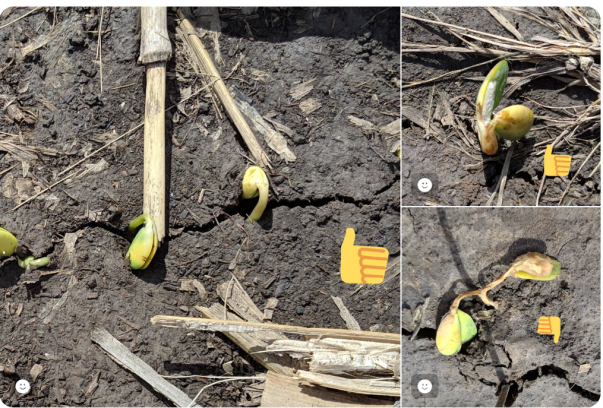May 12th: Youth Virtual Field Tour: Water Erosion featuring Chuck Burr, https://4h.unl.edu/virtual-field-trips
May 13: Field Scout Training, via Zoom, https://extension.unl.edu/statewide/enre/crop/
June 24: Weed Management Field Day, SCAL near Clay Center
July 8: Palmer Amaranth Mgmt Field Day, near Carleton
Aug. 11: Soybean Management Field Days, Hildreth
Aug. 12: Soybean Management Field Days, Elgin
Aug. 13: Soybean Management Field Days, Shelby
Aug. 14: Soybean Management Field Days, Arlington
Aug. 20: Midwest Soil Health Clinic, ENREC
Aug. 25: SCAL Field Day, Clay Center
Aug. 26: Midwest Soybean Production Clinic, ENREC
Aug. 27: Midwest Corn Production Clinic, ENREC
The anticipated cool temps and potential for frost damage were on the minds of several towards the end of last week. The warm spring planting conditions allowed for more soybean emerged in Nebraska and the mid-west than I’ve ever seen before at this time-frame. From UNL small plot and on-farm research, it’s warm springs such as this that have provided the larger yield increases when soybean was planted early. As I’m writing this, low temperatures varied throughout the State Saturday night with more anticipated lows tonight. What should one look for in regards to frost/freeze recovery? First, we’d say to wait 3-5 days post frost to look for signs of regrowth. It may take up to 7 days depending on weather conditions following a frost event. I’ve provided photos in my blog at jenreesources.com to aid in what to watch for and will continue to add photos. Have learned a lot by flagging plants at different growth stages and taking pictures of their recovery. Would encourage you to do the same. One thing we’re always provided is the opportunity to learn!
Survival partly depends on how low temperatures got. Air temperatures of 28°F or less for at least two hours may result in damaged tissue and even death if the growing point is affected in corn and soybean. Air temperatures around 32°F typically don’t result in freeze of plant tissues. Why is this? Plant cells have solutes in the cytoplasm and just outside the cell membrane that act like a modest anti-freeze. Thus, the actual tissue temperature has to reach 28-30°F for frost damage to occur.
It also depends on stage of growth. For emerged corn, the growing point is still in the ground. Frost damage can appear as leaves discoloring and wilting due to plant cells rupturing. Eventually they will turn brown and slough off if new growth pushes through. It will be important to look at the growing point and make sure it’s white/yellow and firm and not discolored and soft. Warmer temps after frost event will help in reducing disease impacts from bacterial pathogens.
Soybeans that are just emerging with the hypocotyl hook exposed at or just above ground level, can be the most at risk for damage. The hypotcotyl hook is the area of the stem below the soybean cotyledon. Anything that impacts it will result in seedling death. Watch for plants that have soft, mushy, or pinched hypocotyls. These are situations where soybean seedlings tend to die. I’ve seen survival in seedlings with light scarring on the hypocotyl and cotyledons where there’s no pinching of the hypocotyl. Cotyledons just at the soil surface or above often will survive due to their high water content. They may have some light scarring yet they tend to survive. Look for the plumule (first true leaves from the shoot) within 7 days post-frost to ensure the growing point wasn’t injured. If unifoliolates were exposed, I’ve seen mixed results (depending on air temperatures and location in the field). Sometimes the unifoliolates will wilt and die but if the axiliary buds by cotyledons survive, new growth will occur.
For wheat, look for any splitting of the stems near the base of plants. Make sure the growing point looks healthy. Damage to wheat in jointing stage occur at 24°F for 2 hours and 28°F for 2 hours at boot. Impacts to wheat later on can also be seen at heading in white awns and spikelets and heads sometimes having difficulty to emerge from the boot (or being twisted). This CropWatch article shares more.
Low areas of fields, fields with coarser soil texture, and lower soil moisture contents can result in more frost damage. Fields receiving rains and wind prior to these cold temperatures may have aided in some protection. There’s often things I can’t explain when assessing frost damage. Sometimes a couple plants in a row will succumb while others around them at the same growth stage are fine. There’s just microclimate things that can’t always be explained. Here’s hoping most fields in the area are ok!
It’s also time to scout for alfalfa weevils and you can see more information and table of thresholds depending on growth stage in this CropWatch article: https://go.unl.edu/a7jw.
Rhubarb and Frost: If rhubarb leaves are not damaged too much and the stalks remain firm, it is still safe to eat. If the leaves are severely damaged or the stalks become soft or mushy, do not eat these stalks. Remove and discard them. New stalks can be harvested and eaten.

These are pics I took in 2019. The soybeans in the left photo had cotyledons just at the soil surface at time of frost. They survived. The upper right-hand photo shows a seedling with light scarring on the hypocotyl and cotyledons. However, the hypocotyl wasn’t pinched and you can see the plumule between the cotyledons is alive and healthy. The lower right-hand photo shows the hypocotyl was damaged on these seedlings causing pinching. Thus these seedlings didn’t survive.




































